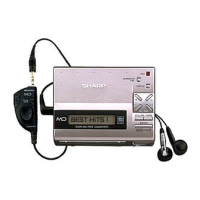There are cases where digital
recording may be impossible.
In the following cases digital recording is
impossible, even if you are using digital
cables.
When you attempt to make a new digital
recording from a track that was digitally
recorded on a MiniDisc
MiniDiscs are designed so that only
first generation digital copies can
made, further digital copies are
prevented by the SCMS (Serial Copy
Management System).
Moisture condensation
In the following cases, condensation
may form inside the unit.
Shortly after turning on a heater.
When the unit is placed in a room
where there is excessive steam or
moisture.
When the unit is moved from a cool
place to a warm place.
When the unit has condensation inside,
the disc signals cannot be read, and the
product may not function properly.
If this happens, remove the disc. The
condensation should evaporate in ap-
proximately 1 hour. The unit will then
function properly.
If trouble occurs
If strange sounds, smell or smoke come
out of the unit or an object is dropped into
the unit, remove the AC adaptor from the
AC socket and contact an authorised
Sharp service centre.
Note:
When this product is subjected to strong
external interference (mechanical shock,
excessive static electricity, abnormal sup-
ply voltage due to lightning, etc.) or if it is
operated incorrectly, it may malfunction. If
such trouble occurs, proceed as follows:
1. Unplug the AC adaptor from the AC
socket.
2. Remove the rechargeable battery.
3. Leave the unit completely unpowered
for approximately 30 seconds.
4. Reconnect the AC adaptor to the AC
socket and retry the operation.
TROUBLESHOOTING
Recording
Playback
CD player, MD
player, etc.
Digitally recorded MiniDisc
Digital cable
Recording
Playback Digital cable
Analogue recording is
possible.
MINIDISC SYSTEM LIMITATIONS
Even if the maximum recording time of
a MiniDisc has not been reached,
“DISC FULL” or “TOC FULL” may be
displayed.
When the number of tracks used
reaches the limit, regardless of the
remaining recording time, further
recording will be impossible.
(Maximum number of tracks: 254)
Even if the number of tracks and the
recording time have not reached the
limit, “DISC FULL” may be displayed.
If there are scratches on a disc, the
unit will automatically avoid recording
in those areas. The recording time will
be reduced.
Even if several short tracks are
erased, the remaining recording time
may not show an increase.
When the remaining recording time of
a disc is displayed, short tracks less
than 8 seconds long may not be
included in the total.
Two tracks may not be combined in
editing.
For MiniDiscs on which repeated
recording and editing operations were
performed, the COMBINE function
may not work.
The total of the recorded time and
time remaining on a disc may not add
up to the maximum possible recording
time.
A cluster (about 2 seconds) is
normally the minimum unit of
recording. So, even if a track is less
than 2 seconds long, it will use about
2 seconds of space on the disc.
Therefore, the time actually available
for recording may be less than the
remaining time displayed.
If there are scratches on discs, those
sections will be automatically avoided
(no recording will be placed in those
sections). Therefore, the recording
time will be reduced.
When recorded tracks are played back
using the cue and review operations,
some sounds may be skipped.
For MiniDiscs on which repeated
recording and editing were performed,
some sounds may be skipped whilst
cueing and reviewing.
A track number can be created in the
middle of a track.
If there are scratches or dust on a
MiniDisc, the track numbers following
that track will be increased by one.

